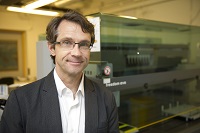Genetics and environment across borders
What are the roles played by environmental and genetic factors in the development of schizophrenia? This question is being examined by an interdisciplinary team of researchers using case and control groups in five different countries. The Tryggve project’s secure IT-based system has been vital in enabling researchers to share data across borders.
“We’ve known for a long time that it’s both genes and environment,” states Professor Patrick Sullivan from the Karolinska Institutet. He is heading a major interdisciplinary research project which combines genetic and environmental data to help researchers to gain a better understanding of how schizophrenia develops.
“The problem is that there are very few places in the world where you can get good environmental measures.” Dr Sullivan says, adding, “The Nordic countries are one of those places, as data have been collected in a careful and rigorous way over a long time.”
So far, no single research group has had access to a test group large enough to investigate this thoroughly. This would require cross-border cooperation, which is difficult because the various countries have different rules and regulations in place concerning the use of sensitive data.
Cooperation yields a larger test group
“For a long time, we’ve wanted to work together and do registry-based research,” Dr Sullivan explains, “but it has been difficult in the absence of a secure framework that is acceptable for the regulators in each country and ethical review committees. The great thing about the Tryggve project has been that is has allowed us to do that in a way that we never really could before.”
Using the Tryggve project’s secure data-sharing systems, researchers have succeeded in putting together a test group comprising 6 000 patients and a control group of 8 750 individuals. At the same time, they have received helpful advice concerning the legal aspects of data sharing.
“One of the great things about the Tryggve project is that we have had an expert helping us to figure out what the relevant laws are – what is doable and what is not doable. They’ve been fantastic,” says Dr Sullivan, who is enthusiastic about the collaboration with the Trygge project team. “They’ve been responsive, professional and extremely helpful in allowing us to use resources that were critical to carrying out this project.”

